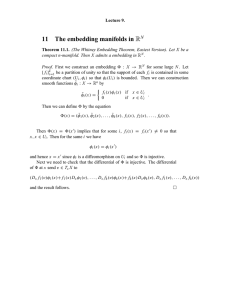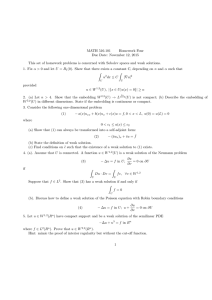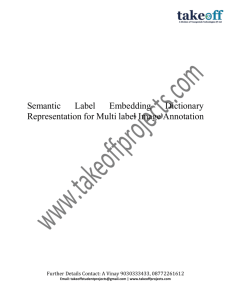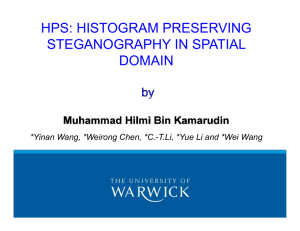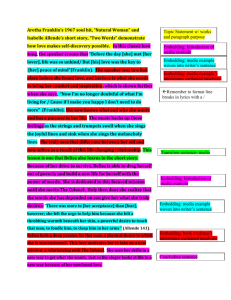Jointly Learning Data-Dependent Label and Locality-Preserving Projections
advertisement
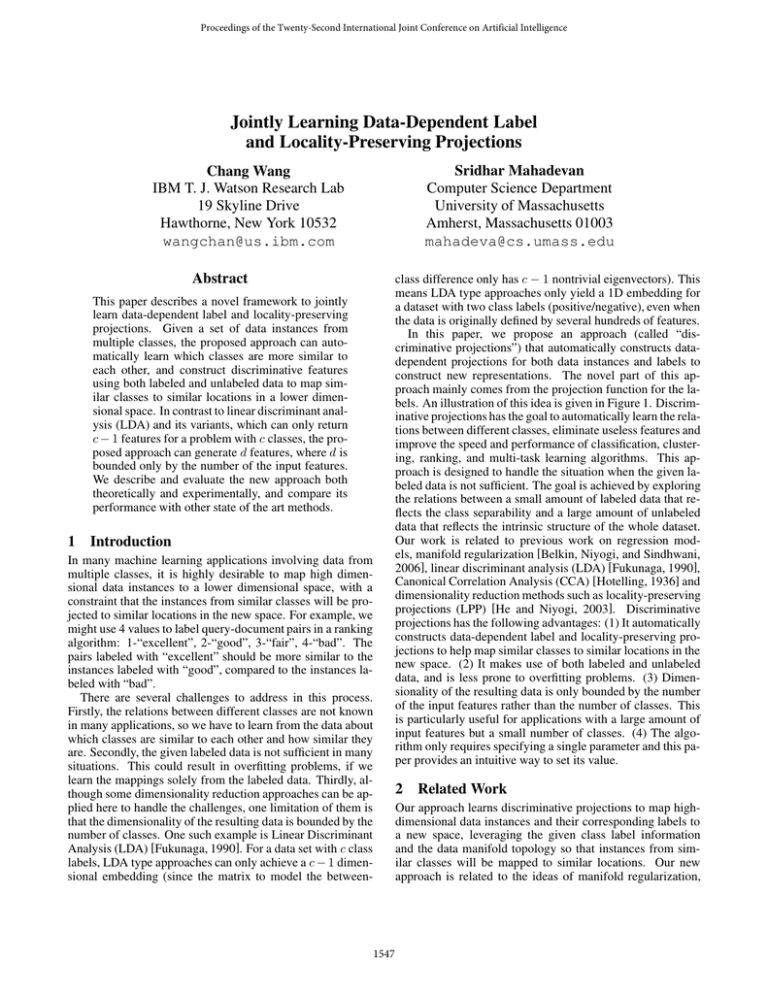
Proceedings of the Twenty-Second International Joint Conference on Artificial Intelligence
Jointly Learning Data-Dependent Label
and Locality-Preserving Projections
Sridhar Mahadevan
Computer Science Department
University of Massachusetts
Amherst, Massachusetts 01003
mahadeva@cs.umass.edu
Chang Wang
IBM T. J. Watson Research Lab
19 Skyline Drive
Hawthorne, New York 10532
wangchan@us.ibm.com
Abstract
This paper describes a novel framework to jointly
learn data-dependent label and locality-preserving
projections. Given a set of data instances from
multiple classes, the proposed approach can automatically learn which classes are more similar to
each other, and construct discriminative features
using both labeled and unlabeled data to map similar classes to similar locations in a lower dimensional space. In contrast to linear discriminant analysis (LDA) and its variants, which can only return
c − 1 features for a problem with c classes, the proposed approach can generate d features, where d is
bounded only by the number of the input features.
We describe and evaluate the new approach both
theoretically and experimentally, and compare its
performance with other state of the art methods.
1 Introduction
In many machine learning applications involving data from
multiple classes, it is highly desirable to map high dimensional data instances to a lower dimensional space, with a
constraint that the instances from similar classes will be projected to similar locations in the new space. For example, we
might use 4 values to label query-document pairs in a ranking
algorithm: 1-“excellent”, 2-“good”, 3-“fair”, 4-“bad”. The
pairs labeled with “excellent” should be more similar to the
instances labeled with “good”, compared to the instances labeled with “bad”.
There are several challenges to address in this process.
Firstly, the relations between different classes are not known
in many applications, so we have to learn from the data about
which classes are similar to each other and how similar they
are. Secondly, the given labeled data is not sufficient in many
situations. This could result in overfitting problems, if we
learn the mappings solely from the labeled data. Thirdly, although some dimensionality reduction approaches can be applied here to handle the challenges, one limitation of them is
that the dimensionality of the resulting data is bounded by the
number of classes. One such example is Linear Discriminant
Analysis (LDA) [Fukunaga, 1990]. For a data set with c class
labels, LDA type approaches can only achieve a c − 1 dimensional embedding (since the matrix to model the between-
1547
class difference only has c − 1 nontrivial eigenvectors). This
means LDA type approaches only yield a 1D embedding for
a dataset with two class labels (positive/negative), even when
the data is originally defined by several hundreds of features.
In this paper, we propose an approach (called “discriminative projections”) that automatically constructs datadependent projections for both data instances and labels to
construct new representations. The novel part of this approach mainly comes from the projection function for the labels. An illustration of this idea is given in Figure 1. Discriminative projections has the goal to automatically learn the relations between different classes, eliminate useless features and
improve the speed and performance of classification, clustering, ranking, and multi-task learning algorithms. This approach is designed to handle the situation when the given labeled data is not sufficient. The goal is achieved by exploring
the relations between a small amount of labeled data that reflects the class separability and a large amount of unlabeled
data that reflects the intrinsic structure of the whole dataset.
Our work is related to previous work on regression models, manifold regularization [Belkin, Niyogi, and Sindhwani,
2006], linear discriminant analysis (LDA) [Fukunaga, 1990],
Canonical Correlation Analysis (CCA) [Hotelling, 1936] and
dimensionality reduction methods such as locality-preserving
projections (LPP) [He and Niyogi, 2003]. Discriminative
projections has the following advantages: (1) It automatically
constructs data-dependent label and locality-preserving projections to help map similar classes to similar locations in the
new space. (2) It makes use of both labeled and unlabeled
data, and is less prone to overfitting problems. (3) Dimensionality of the resulting data is only bounded by the number
of the input features rather than the number of classes. This
is particularly useful for applications with a large amount of
input features but a small number of classes. (4) The algorithm only requires specifying a single parameter and this paper provides an intuitive way to set its value.
2 Related Work
Our approach learns discriminative projections to map highdimensional data instances and their corresponding labels to
a new space, leveraging the given class label information
and the data manifold topology so that instances from similar classes will be mapped to similar locations. Our new
approach is related to the ideas of manifold regularization,
Figure 1: Illustration of regular learning approaches (A), and our
approach (B).
LDA, regular dimensionality reduction and Canonical Correlation Analysis.
Linear regression involves estimating a coefficient vector
to map the data instances to real-valued outputs (or continuous class labels). For example, given a set of instances {xi }
defined in a p dimensional space, a linear regression model
computes β0 , · · · , βp such that label yi can be approximated
by
yˆi = β0 + β1 xi (1) + · · · + βp xi (p) for i = 1, . . . , n.
The framework of manifold regularization [Belkin, Niyogi,
and Sindhwani, 2006] combines the standard loss functions
associated with regression or classification with an additional
term that preserves the local geometry of the given data manifold (the framework has another term corresponding to an
ambient regularizer). One problem solved under this framework can be characterized as follows: given an input dataset
X = (x1 , · · · , xm ) and label information Y = (y1 , · · · , yl )
(l ≤ m), we want to compute a function f that maps xi to a
new space, where f T xi matches xi ’s label yi . In addition, we
also want f to preserve the neighborhood relationship within
dataset X (making use of both labeled and unlabeled data).
This problem can be viewed as finding an f that minimizes
the cost function:
C(f ) =
i≤l
(f T xi − yi )2 + μ
(f T xi − f T xj )2 WX (i, j). (1)
i,j
these approaches is that when they learn lower dimensional
embeddings, they do not take label information into account.
So only the information that is useful to preserve the topology of the whole manifold is guaranteed to be kept, and the
discriminative information separating instances from different classes may be lost. For example, when we are required to
describe a human being with a couple of words, we may use
such characteristics as two eyes, two hands and so on. However, none of these features is useful to separate men from
women.
Linear Discriminant Analysis (LDA) and some of its extensions like semi-supervised discriminant analysis [Cai, He,
and Han, 2007; Zhao et al., 2007] find a dimensionalityreducing projection that best separates two or more classes
of objects or events. The resulting combination may be used
as a linear classifier, or for dimensionality reduction before
later classification. However, for a dataset with c class labels, LDA type approaches can only achieve a c − 1 dimensional embedding (since the matrix to model the betweenclass difference only has c − 1 nontrivial eigenvectors). The
proposed approach can be distinguished from some recent
work. LDPP [Villegas and Paredes, 2008] learns the dimensionality reduction and nearest neighbor classifier parameters
jointly. LDPP does not preserve the topology of the given
dataset. The algorithm in [Pham and Venkatesh, 2008] provides a framework to learn a (local optimal) linear mapping
function that maps the given data to a new space in order
to enhance a given classifier. Their mapping function is designed for classification only and does not preserve the topology of the dataset. [Zhang, Zhou, and Chen, 2007] incorporates pairwise constraints for finding a better embedding.
This approach does not consider the fact that some classes
are more similar to each other compared to the other classes.
Similar to our approach, the well-known Canonical Correlation Analysis (CCA) [Hotelling, 1936] and recent work
on label embedding [Weinberger and Chapelle, 2008] also simultaneously compute two mapping functions. For example,
CCA finds linear functions that map instances from two different sets to one space, where the correlation between the
corresponding points is maximized. There is a fundamental
difference between our approach and these approaches: Our
approach can make use of unlabeled data to handle overfitting
problems, while approaches like CCA cannot.
3 Overall Framework
We can interpret the first mean-squared error term of C(f )
as penalizing the difference between a one-dimensional projection of the instance xi and the label yi . The second
term enforces the preservation of the neighborhood relationship within X (where WX is a similarity measure). Under
this interpretation, manifold regularization constructs embeddings preserving both the topology of the manifold and a 1dimensional real-valued output structure. The proposed approach generalizes this idea to compute higher order localitypreserving discriminative projections.
Many linear (e.g., PCA, LPP) and nonlinear (e.g., Laplacian eigenmaps [Belkin and Niyogi, 2003]) dimensionality
reduction methods convert dimensionality reduction problems to an eigenvalue decomposition. One key limitation of
We introduce the overall framework in this section. It is helpful to review the notation described below. In particular, we
assume that class labels can be viewed as c-dimensional realvalued vectors if there are c possible labels.
3.1
The Problem
Assume the given dataset X = (x1 , · · · , xm ) is a p × m
matrix, where instance xi is defined by p features. c = number
of classes in X. Label yi is a c × 1 vector representing xi ’s
class label. If xi is from the j th class, then yi (j) = 1; yi (k) =
0 for any k = j. We also assume xi ’s label is given as yi for
1 ≤ i ≤ l; xi ’s label is not available for l + 1 ≤ i ≤ m.
Y = (y1 , · · · , yl ) is a c × l matrix.
1548
The problem is to compute mapping functions f (for data
instances) and g (for labels) to map data instance xi ∈ Rp
and label yi ∈ Rc to the same d-dimensional space, where
the topology of the data manifold is preserved, the instances
from different classes are separated and d p. Here, f is a
p × d matrix and g is a c × d matrix.
3.2
The Cost Function
The solution to the overall problem of learning discriminative projections can be formulated as constructing mapping
functions f and g that minimize the cost function C(f, g) =
i≤l
f T xi − g T yi 2 + μ
c
i≤l
k=1,sk =yi
i,j
f T xi − f T xj 2 WX (i, j)
f T xi − g T sk 2
,
where sk and WX are defined as follows: sk is a c×1 matrix.
sk (k) = 1, and sk (j) = 0 for any j = k. Sk is a c × l
matrix= (sk , · · · , sk ). WX is a matrix, where WX (i, j) is the
similarity (could be defined by k-nearest neighbor approach)
between xi and xj .
Here, f T xi is the mapping result of xi . g T yi (or g T sk ) is
the mapping result of label yi (or sk ). The first term in the
numerator represents the difference between the projection
result of any instance xi and its corresponding label yi . We
want this value to be small, since this makes xi be close to
its true label. The second term in the numerator models the
topology of dataset X using both labeled and unlabeled data.
When it is small, it encourages the neighborhood relationship
within X to be preserved. μ is a weight to balance the first
and second terms. It is obvious that we want the numerator of
C(f, g) to be as small as possible. The denominator models
the distance between the projection result of each instance
xi and all the labels other than the correct label. We want
this value to be as large as possible, since this makes xi be
far away from its wrong labels. Thus, minimizing C(f, g) is
equal to learning f and g jointly to preserve the topology of
dataset X, and project instances to a new lower dimensional
space, where the instances from the same class are close to
each other and the instances from different classes are well
separated from each other.
3.3
the label vector by different amounts, which then allows better projections of points. With the flexibility offered by g, we
can project similar classes to similar locations (this is learned
from the data manifold topology), and achieve the embedding
results of a dimensionality bounded by the number of input
features rather than the number of classes (without using g,
our result is also bounded by c).
In summary, the numerator of our loss function encourages
the instances with the same label to stay together, preserving the data manifold topology. The denominator of the loss
function encourages the instances with different labels to be
away from each other. The mapping g provides the best label projection with regard to the given loss function, and the
mapping f projects the data to match the resulting new labels. Manifold topology is respected to handle the possible
overfitting problems.
3.4
Discriminative Projections: The Main
Algorithm
Some notation used in the algorithm is as follows:
γ = (f T , g T )T is a (p + c) × d matrix. T r() means trace.
I is an l × l identity matrix. LX is a graph Laplacian
matrix[Belkin and
to WX .
Niyogi, 2003] corresponding
I 0
I
U1 =
, U = U3T =
, U = I.
0 0 m×m 2
0 m×l 4
The algorithmic procedure is as follows:
1. Construct matrices A, B and C:
T
X
X 0
U1
−U2
0
−U3
U4
0 Y
0
YT
c
X
0
U1
XT
−U2
0
0 Sk
−U3
U4
0
SkT
k=1
T
μLX 0
X
X 0
0
0 Y
0
0
0
YT
A
=
B
=
C
=
2. Compute γ = (γ1 , · · · , γd ): the d minimum eigenvectors of the generalized eigenvalue decomposition
equation:
High Level Explanation
(A + C)x = λ(B + C)x.
Manifold regularization addresses the problem of learning
projections to map the data instances (with known labels)
to their class labels, preserving the manifold topology of the
whole dataset (considering both labeled and unlabeled data).
The ability to make use of unlabeled data reduces the possibility of overfitting. A loss function example under this
framework is described in Equation (1), and can be generalized for our problem. Our goal is to jointly separate the
instances from different classes and learn data-dependent labels, so whether the data will be projected to its original label
is not important as long as the instances from the same class
will stay together and the instances from different classes will
be separated. In our algorithm, we have a mapping function f
for data instances, and g for labels such that f and g can work
together to map the data instances and labels to a new space,
where the instances and their new labels are matched. The
mapping g is decided by both the given class labels and the
data manifold topology, and allows us to scale the entries of
3. Compute discriminative projections f and g:
γ = (γ1 , · · · , γd ) is a (p + c) × d matrix, whose top
p rows= mapping function f , the next c rows= mapping
function g. i.e.
f
= (γ1 , · · · , γd ).
g
4. Compute the d-dimensional embedding of dataset X:
The d-dimensional embedding of X is f T X, whose ith
column represents the embedding of xi .
3.5
Justification
Theorem 1. The d minimum eigenvector solutions of the
equation (A + C)x = λ(B + C)x provide the optimal ddimensional discriminative projections to minimize the cost
function C(f, g).
1549
4 Experimental Results
Proof: Given the input and the cost function, the problem is
formalized as:
{f, g} = argf,g min(C(f, g)).
When d = 1, we define M, N and L as follows:
c
M=
(f T xi − g T yi )2 , N =
(f T xi − g T sk )2 ,
i≤l
L=μ
i≤l k=1
(f T xi − f T xj )2 WX (i, j).
i,j
argf,g min(C(f, g))
M +L
N −M
= argf,g max
N −M
M +L
N +L
M +L
= argf,g max
= argf,g min
.
M +L
N +L
T X f
U1 −U2
= (f T X, g T Y )
= γ T Aγ.
−U3 U4
Y Tg
f
= (f T , g T )B
= γ T Bγ.
g
= argf,g min
In this section, we test discriminative projections, LDA, CCA
and LPP using two datasets: recognition of handwritten digits using the USPS dataset (an image dataset with multiple
classes), and TDT2 data (a text dataset with multiple classes).
We use the following simple strategy to decide the value of μ
in the loss function C(f, g). Let s be the sum of all entries
of WX and l = the number of training examples with labels,
then l/s balances the scales of the first term and second term
in the numerator of C(f, g). We let μ = l/s, if we treat accuracy and topology preservation as equally important. We
let μ > l/s, when we focus more on topology preservation;
μ < l/s, when accuracy is more important. In this paper, we
use μ = l/s for discriminative projections.
4.1
USPS Digit Data (Image Data)
The USPS digit dataset (www.gaussianprocess.org/gpml/data)
has 9298 images. We randomly divided it into a training set
M
(2000 cases) and a test set (7298 cases). Each image contains
a raster scan of the 16 × 16 grey level pixel intensities. The
N
intensities have been scaled to the range [-1, 1].
We first computed lower dimensional embeddings of the
L = μf T XLX X T f = γ T Cγ.
data using discriminative projections, LDA, CCA and Locality Preserving Projections (LPP). This dataset has 10 labels,
γ T (A + C)γ
so LDA can only return an embedding of 9 or less dimenargf,g min C(f, g) = argf,g min T
.
γ (B + C)γ
sions. LPP, CCA and discriminative projections can return an
It follows directly from the Lagrange multiplier method that
embedding of any dimensionality. The 3D and 2D embedding
the optimal solution that minimizes the loss function C(f, g)
results are shown in Figure 2.
is given by the minimum eigenvector solution to the generalTo quantitatively study how the discriminative information
ized eigenvalue problem: (A + C)x = λ(B + C)x.
is preserved by different approaches, we ran a leave-oneWhen d > 1,
out test. We first computed 9D and 100D embeddings us
T
T
2
T
f xi − g yi = T r((γ1 · · · γd ) A(γ1 · · · γd )). ing discriminative projections, LPP and CCA. We also comM =
puted 9D embedding using LDA. Then we checked for each
i≤l
point xi whether at least one point from the same class were
c
among its K nearest neighbors in the new space. We tried
f T xi − g T sk 2
N =
K = 1, · · · , 10. The results are summarized in Figure 3.
i≤l k=1
From the figure, we can see that discriminative projections
= T r((γ1 · · · γd )T B(γ1 · · · γd )).
(100 dimensional), and LPP (100 dimensional) achieve sim
ilar performance (LPP is slightly worse), and outperform the
T
T
2
L = μ
f xi − f xj WX (i, j)
other approaches. This shows that discriminative projections
i,j
and LPP with more features are able to better preserve the
= T r((γ1 · · · γd )T C(γ1 · · · γd )).
discriminative information of the given dataset compared to
using less features. Recall that the mapping results from LDA
argf,g min C(f, g)
are bounded by the number of classes, and can not generate
T r((γ1 · · · γd )T (A + C)(γ1 · · · γd ))
embedding results of high dimensionality in this test. Com= argf,g min
.
paring all 4 approaches resulting in 9D embedding results,
T r((γ1 · · · γd )T (B + C)(γ1 · · · γd ))
CCA and LDA are still worse than Discriminative projections
Standard approaches [Wilks, 1963] show that the solution to
and LPP. We checked the projection results of the training
γ1 · · · γd that minimizes C(f, g) is provided by the eigenvecdata, and found that CCA and LDA worked perfectly for the
tors corresponding to the d lowest eigenvalues of the equatraining data. This implies that LDA and CCA results overfittion: (A + C)x = λ(B + C)x.
ted for the training data, and did not generalize well to the test
The mapping functions f and g are linear. For them to be
data. On the contrary, discriminative projections and LPP are
nonlinear, we can directly compute the embedding result of
unlikely to run into overfitting, since they take the unlabeled
each given instance and label (use ui to replace f T xi and vj
data into consideration when the projections are constructed.
We also used this example to visualize the new “prototype”
to replace g T yj ). The corresponding cost function and algoof each label in a 2D space (Figure 4). The original labels
rithm can be given in a similar manner as the linear case disare in a 10D space. The new labels are constructed by procussed in this paper. This new problem is in fact technically
jecting the old labels onto the space spanned by the first two
less challenging. The same problem can also be solved using
columns of mapping function g. When μ = 103 , we can see
the framework of kernel CCA [Kuss and Graepel, 2003].
1550
(A)
(E)
(C)
0.25
0.15
0.2
0.1
0.15
0.05
0.1
0
2
(G)
0.4
0.1
6
7
0.05
0.2
2
0
0
0.05
−0.05
0
−0.1
−0.05
−0.1
0.5
−0.05
−0.2
−0.1
−0.15
0
−0.5
−0.2
−0.5
0.5
0
−0.5
0
0.5
−0.4
−1
0
−0.5
(B)
0.5
0
−0.15
0.2
1
(D)
0.3
0.6
0.4
0.2
0.8
0
−0.2
−0.26
(F)
0.3
1
0.25
0.8
0.2
5
−0.23
0
8
(H)
0.15
0.1
0.6
0.2
−0.25
−0.24
3 6
9
4
1
5
7
0
1
3
9
4
8
0.05
0.4
0.1
0.15
0
0.2
0.1
0
−0.05
0
0.05
−0.1
0
−0.2
−0.2
0
0.2
0.4
0.6
−0.05
−0.3
−0.1
−0.2
−0.15
−0.4
−0.2
−0.1
0
−0.6
0.2
0.1
0.4
0.6
0.8
−0.2
−0.26
−0.25
−0.24
Figure 4: (left) Projection results of 10 USPS digit labels (μ=1000).
−0.23
(right) Projection results of 10 USPS digit labels (μ=0.001).
Figure 2: USPS digit test: (the color represents class label): (A)
discriminative projections using 3D embedding; (B) discriminative
projections using 2D embedding; (C) LDA using 3D embedding;
(D) LDA using 2D embedding; (E) LPP using 3D embedding; (F)
LPP using 2D embedding; (G) CCA using 3D embedding; (H) CCA
using 2D embedding.
1
Percentage
0.95
0.9
Discriminative Projections (100D Embedding)
Discriminative Projections (9D Embedding)
LDA (9D Embedding)
LPP (100D Embedding)
LPP (9D Embedding)
CCA (100D Embedding)
CCA (9D Embedding)
0.85
0.8
0.75
1
2
3
4
5
6
7
8
9
10
K
Figure 3: USPS test: This experiment measures how well the discriminative information is preserved.
from the left figure that new labels of similar digits are close
to each other in the new space. For example, ‘0’ and ‘8’ are
together; ‘3’, ‘6’ and ‘9’ are also close to each other. When
μ is large, we focus more on topology preservation. The result makes sense, since to preserve local topology of the given
dataset, similar digits have a large chance of being projected
to similar locations. We ran another test with less respect to
manifold topology (by setting μ = 10−3 ). In the new scenario, the new labels were much better separated in the new
space (right figure). This experiment shows that the mapping
g allows us to scale the entries of the label vector by different
amounts for different applications, which then allows more
flexible projections of instances.
4.2
TDT2 Data (Text Data)
The TDT2 corpus consists of data collected during the first
half of 1998 and taken from 6 sources, including 2 newswires
(APW, NYT), 2 radio programs (VOA, PRI) and 2 television
programs (CNN, ABC). It consists of more than 10,000 documents which are classified into 96 semantic categories. In the
dataset we are using, the documents that appear in more than
one category were removed, and only the largest 4 categories
were kept, thus leaving us with 5,705 documents in total.
1551
We applied our approach, LDA, CCA and LPP to the TDT2
data assuming label information of 1/3 documents from each
class was given, i.e. l = 5, 705/3. To see how the discriminative information is preserved by different approaches, we ran
a similar leave-one-out test. Again, we first computed 3D and
100D embeddings using discriminative projections CCA and
LPP. We also computed the 3D embedding using LDA. Then
we checked for each document xi whether at least one document from the same class was among its K nearest neighbors in the new space (we use this as correctness). We tried
K = 1, · · · , 10. The results are summarized in Figure 5.
From this figure, we can see that discriminative projections
perform much better than the other approaches in all 10 tests
followed by LPP (100D), LPP(3D), LDA(3D) CCA(100D)
and CCA(3D).
Generally speaking, LDA does a good job at preserving
discriminative information, but it does not preserve the topology of the given manifold and not suitable for many dimensionality reduction applications, which need an embedding
defined by more than c − 1 features. Further, when the labeled data is limited, LDA could run into overfitting problems. Similar to LDA, CCA is also likely to have overfitting
problems when the labeled data is not sufficient. To see how
overfitting problems affect the performance, we applied all
four approaches to the data, and visualized the 2D embedding
results of the training data and test data in Figure 6. The figure
shows that the training and test embedding results of discriminative projections and LPP are similar, but quite different for
CCA and LDA. For CCA and LDA, the embedding results
of the training data from each individual class converge to a
single point in the figure. However, the embedding results
are scattered across the figures for the test data. This strongly
indicates that their projection functions are over-tuned to the
training data and do not generalize well to the test data. As
a representative approach of regular dimensionality reduction
approaches, LPP can preserve the manifold topology, return
the embedding result of a dimensionality only bounded by the
number of input features. However, LPP totally disregards
the label information, and behaved much worse than discriminative projections in this test: 10% worse on 100D embedding and 25% worse on 3D embedding results. Discriminative projections combines the ideas of LDA, CCA and LPP,
such that both manifold topology and the class separability
will be preserved. In addition, depending on the applications,
users may decide how to choose μ to balance the two goals. If
we focus more on the manifold topology, we choose a larger
Acknowledgments
1
We thank the reviewers for their helpful comments. This
material is based upon work supported by the National Science Foundation under Grant Nos. NSF CCF-1025120, IIS0534999, and IIS-0803288.
0.9
Percentage
0.8
0.7
Discriminative Projections (100D Embedding)
Discriminative Projections (3D Embedding)
LDA (3D Embedding)
LPP (100D Embedding)
LPP (3D Embedding)
CCA (100D Embedding)
CCA (3D Embedding)
0.6
0.5
References
0.4
1
2
3
4
5
6
7
8
9
10
K
Figure 5: TDT2 test: This experiment measures how well the discriminative information is preserved.
(A)
(C)
0.3
0.15
0.2
0.1
(E)
−4
20
x 10
0.1
x 10
1
0.05
0
0
−0.1
−0.05
−0.2
−0.1
10
0
5
−1
0
−0.3
−0.4
−0.2
(G)
−10
2
15
−2
−0.15
0
0.2
0.4
0.6
−0.2
−0.1
0
0.1
0.2
0.3
−5
−0.01
0
0.01
0.02
−3
−5
0
5
10
−10
x 10
(B)
(D)
0.4
(F)
−4
1
20
x 10
(H)
0.15
0.5
0.1
0.2
15
0
0
0.05
10
−0.5
−1
−0.2
0
−0.05
5
−1.5
−0.1
−0.4
0
−2
−0.6
−0.5
0
0.5
−2.5
−1
−0.15
0
1
2
−5
−0.01
0
0.01
0.02
−0.2
−1
−0.5
0
0.5
1
Figure 6: USPS digit test: (the color represents class label): (A)
discriminative projections using 2D embedding (training); (B) LDA
using 2D embedding (training); (C) LPP using 2D embedding (training); (D) CCA using 2D embedding (training); (E) discriminative
projections using 2D embedding (testing); (F) LDA using 2D embedding (testing); (G) LPP using 2D embedding (testing); (H) CCA
using 2D embedding (testing).
value for μ; otherwise, we choose a smaller value for μ.
5 Conclusions
In this paper, we introduced a novel approach (“discriminative projections”) to jointly learn data-dependent label and
locality-preserving projections. The new approach is able
to construct discriminative features to map high-dimensional
data instances to a new lower dimensional space, preserving
both manifold topology and class separability. Leveraging
the flexibility of labels, discriminative projections goes beyond LDA and LPP in that it can project similar classes to
similar locations, and provide an embedding of an arbitrary
dimensionality rather than c − 1 for LDA in a problem with c
class labels. It also differs from the other regular dimensionality reduction since the discriminative information to separate instances from different classes will be preserved. Our
approach is a semi-supervised approach making use of both
labeled and unlabeled data. It is general, since it can handle
both two class and multiple class problems. In addition to
the theoretical validations, we also presented real-world applications of our approach to information retrieval and a digit
recognition task in image analysis.
1552
[Belkin and Niyogi, 2003] Belkin, M., and Niyogi, P. 2003.
Laplacian eigenmaps for dimensionality reduction and
data representation. Neural Computation 15:1373–1396.
[Belkin, Niyogi, and Sindhwani, 2006] Belkin, M.; Niyogi,
P.; and Sindhwani, V. 2006. Manifold regularization: a
geometric framework for learning from labeled and unlabeled examples. Journal of Machine Learning Research
2399–2434.
[Cai, He, and Han, 2007] Cai, D.; He, X.; and Han, J. 2007.
Semi-supervised discriminant analysis. In Proceedings of
the International Conference on Computer Vision (ICCV).
[Fukunaga, 1990] Fukunaga, K. 1990. Introduction to statistical pattern classification. Academic Press.
[He and Niyogi, 2003] He, X., and Niyogi, P. 2003. Locality
preserving projections. In Proceedings of the Advances in
Neural Information Processing Systems (NIPS).
[Hotelling, 1936] Hotelling, H. 1936. Relations between two
sets of variates. Biometrika 10:321–377.
[Kuss and Graepel, 2003] Kuss, M., and Graepel, T. 2003.
The geometry of kernel canonical correlation analysis.
Technical report, Max Planck Institute for Biological Cybernetics.
[Pham and Venkatesh, 2008] Pham, D. S., and Venkatesh, S.
2008. Robust learning of discriminative projection for
multicategory classification on the stiefel manifold. In
Proceedings of the IEEE Conference on Computer Vision
and Pattern Recognition (CVPR).
[Villegas and Paredes, 2008] Villegas, M., and Paredes, R.
2008. Simultaneous learning of a discriminative projection and prototypes for nearest-neighbor classification. In
Proceedings of the IEEE Conference on Computer Vision
and Pattern Recognition (CVPR).
[Weinberger and Chapelle, 2008] Weinberger,
K.,
and
Chapelle, O. 2008. Large margin taxonomy embedding
for document categorization. In Proceedings of the
Advances in Neural Information Processing Systems.
[Wilks, 1963] Wilks, S. S. 1963. Mathematical statistics.
Wiley.
[Zhang, Zhou, and Chen, 2007] Zhang, D.; Zhou, Z.; and
Chen, S. 2007. Semi-supervised dimensionality reduction.
In In Proceedings of the 7th SIAM International Conference on Data Mining, 11–393.
[Zhao et al., 2007] Zhao, D.; Lin, Z.; Xiao, R.; and Tang, X.
2007. Linear laplacian discrimination for feature extraction. In Proceedings of the IEEE Conference on Computer
Vision and Pattern Recognition (CVPR).
